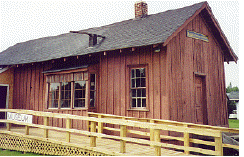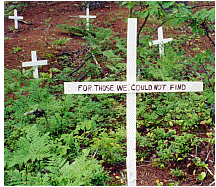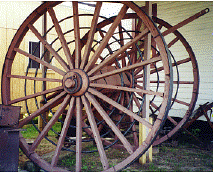A Little History of
Seney, MI started out as a little settlement located by the
tracks of the Duluth, South Shore, and Atlantic railroad, Some say the town was named for one of the contractors on the railroad as were some of the nearby villages. The Upper Peninsula was a vast forest of white pine, so in 1882
the Alger, Smith Company began logging and other companies soon
followed. Seney was suddenly the center of the logging Much of the town was built up on 6 foot cedar posts because of the swampy land and the depth of the snow. There were about 21 saloons, 10 hotels, a church, drug stores, meat markets, general merchandise stores, a jewelry store, other businesses, and several hundred houses. The quiet little village of Seney was now a roaring lumber town and had become notorious. The cemetery, Boot Hill, was located just south of Seney, where the tall pines still stand guard over the long gone loggers. Logging was conducted during the winter as it was easier to move the logs on sleds or with big wheels because of the deep snow. The sleds and big wheels were pulled by oxen, mules, or horses.
The logs were moved to the Fox River and piled up until the spring thaw and then they traveled down the river to Manistique where they were sent to the saw-mills. Much of this wood was used to build homes in the midwest. Some wood was also hauled to Grand Marais and sent to England. This boom lasted for about 15 years. During this time, Seney was plagued by fires and the pines were logged so the loggers and shopkeepers soon followed the big pines to new camps. There were two major forest fires, in 1891 and 1895, but Seney never totally burned to the ground. Other towns grew and Seney became an almost abandoned village. The population dropped to about 300 and is now a very pleasant village with outstanding recreational facilities for all seasons. From Ernest Hemingway, The Big Two Hearted River: "The train went on up the track out of sight, around one of the hills of burnt timber. Nick sat down on the bundle of canvas and bedding the baggage man had pitched out of the door of the baggage car...The thirteen saloons that had lined the one street of Seney had not left a trace... The river was there. It swirled against the log spiles of the bridge. Nick looked down into the clear brown water, colored from the pebbly bottom, and watched the trout keeping themselves steady in the current with wavering fins. As he watched them they changed their positions by quick angles, only to hold steady in the fast water again. Nick watched them a long time... Nick's heart tightened as the trout moved. He felt all the old feeling."
Upper Peninsula Towns
and Cities Page Information on the History of Seney courtesy of Al Seccia, Seney Country Inn. Copyright 2000 by vivian wood, the webmaster for Exploring the North, Inc. All Rights Reserved. Except as permitted under the Copyright Act of 1976, as Amended, this web site may not be reproduced in whole or in part in any manner. Unless authorized by the webmaster of Exploring the North, Inc., reproduction of any web page or pages on the Exploring the North website for placement on the internet is a copyright infringement. All right, title and interest in and to the material on the web pages, the web site, in whole or in part, and in and to this url and the urls contained within, is the property of vivian wood, the webmaster for Exploring the North, Inc. Web page created on an Apple G-4 |

 industry and this little hamlet abruptly grew to become a thriving
town of around 3000 people, and many more when the lumberjacks came
in from the 15 or more nearby camps.
industry and this little hamlet abruptly grew to become a thriving
town of around 3000 people, and many more when the lumberjacks came
in from the 15 or more nearby camps. 